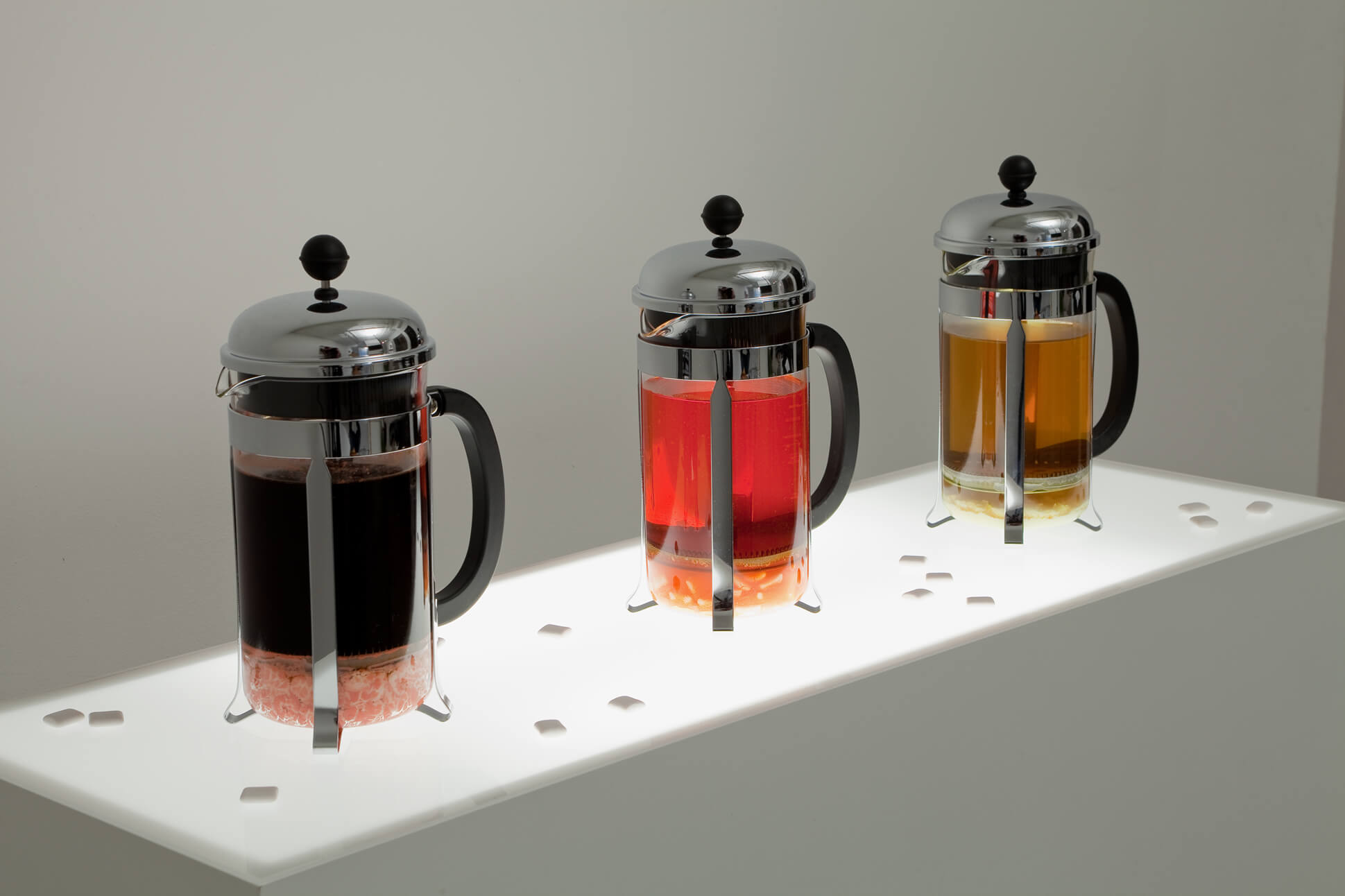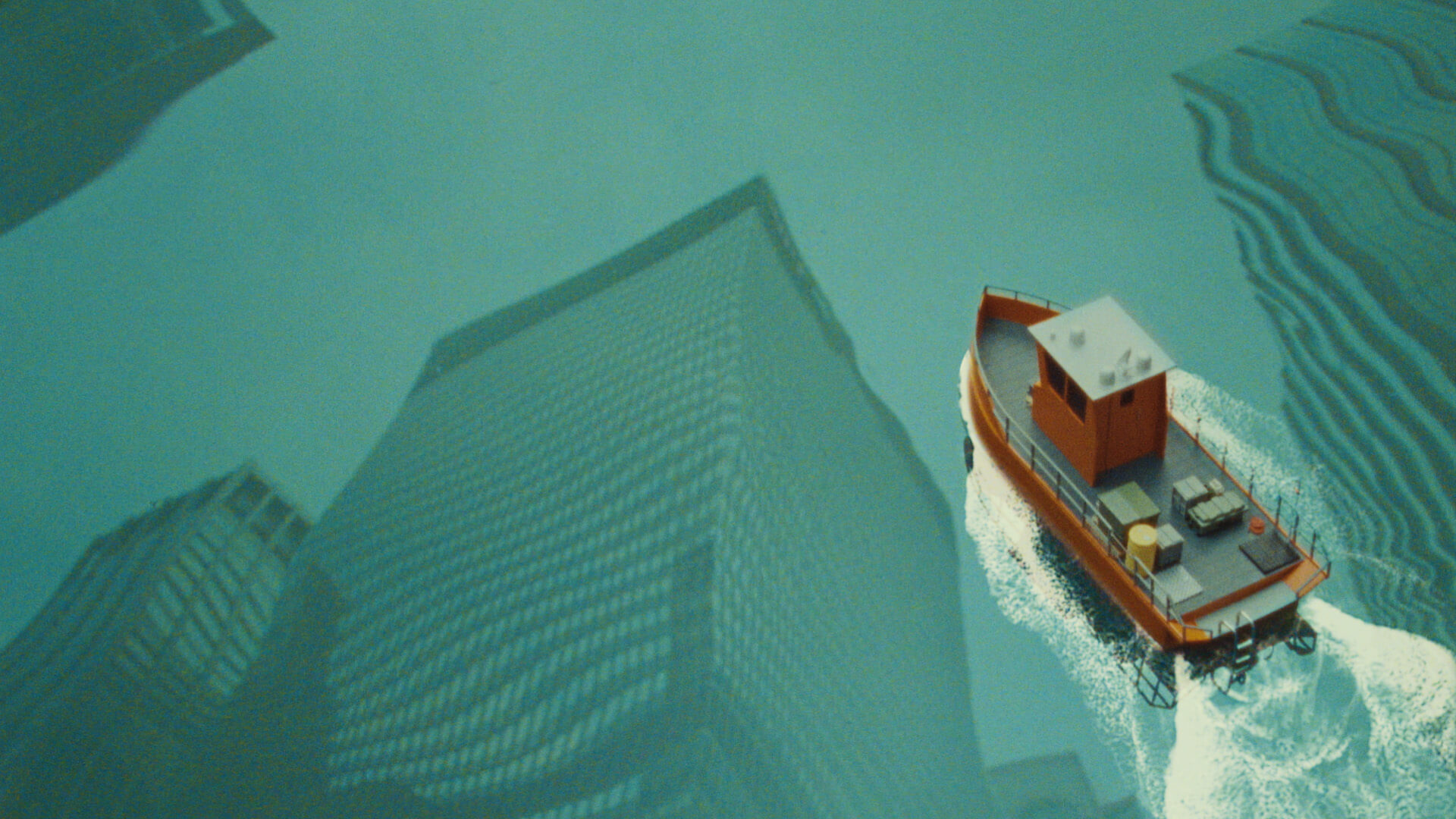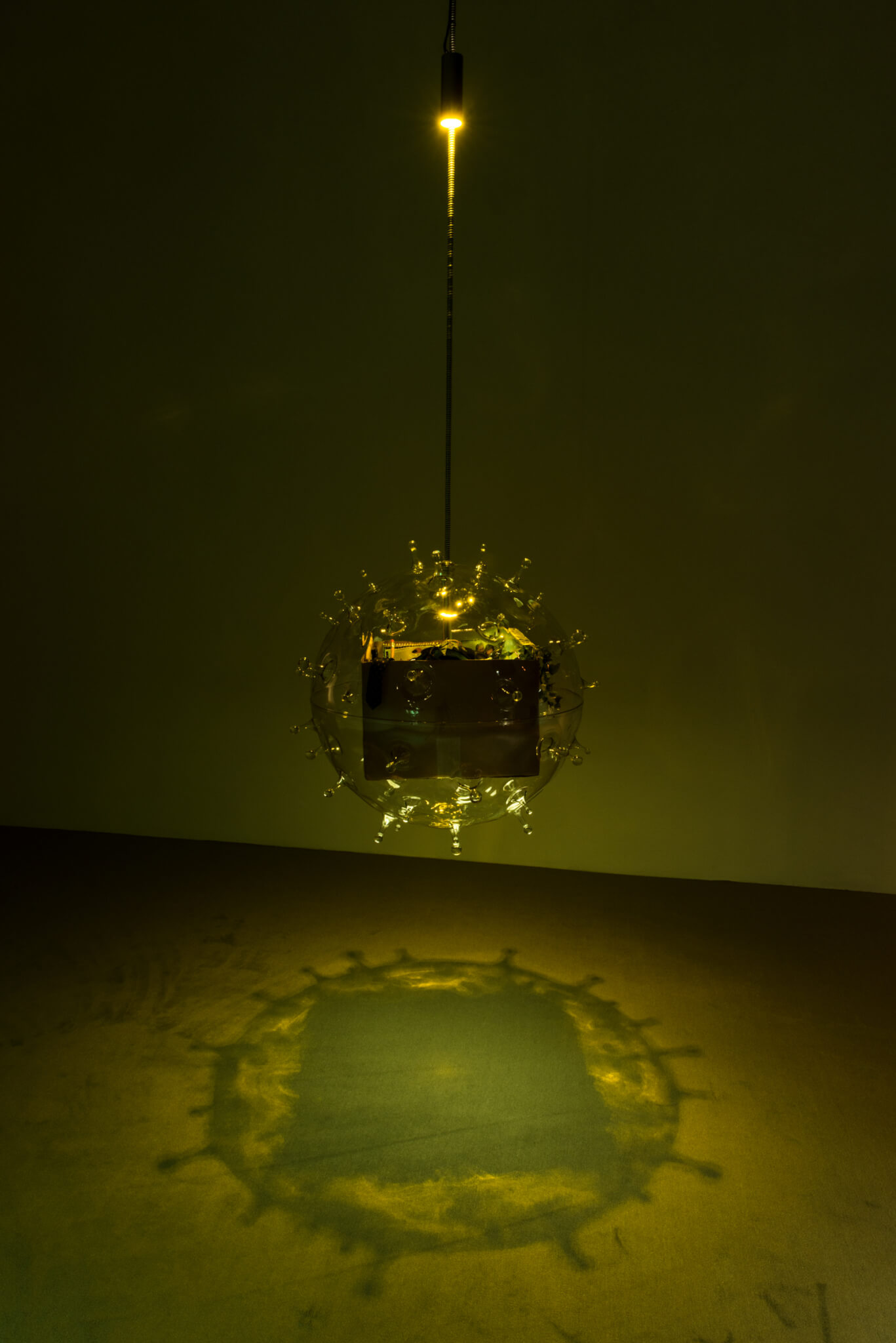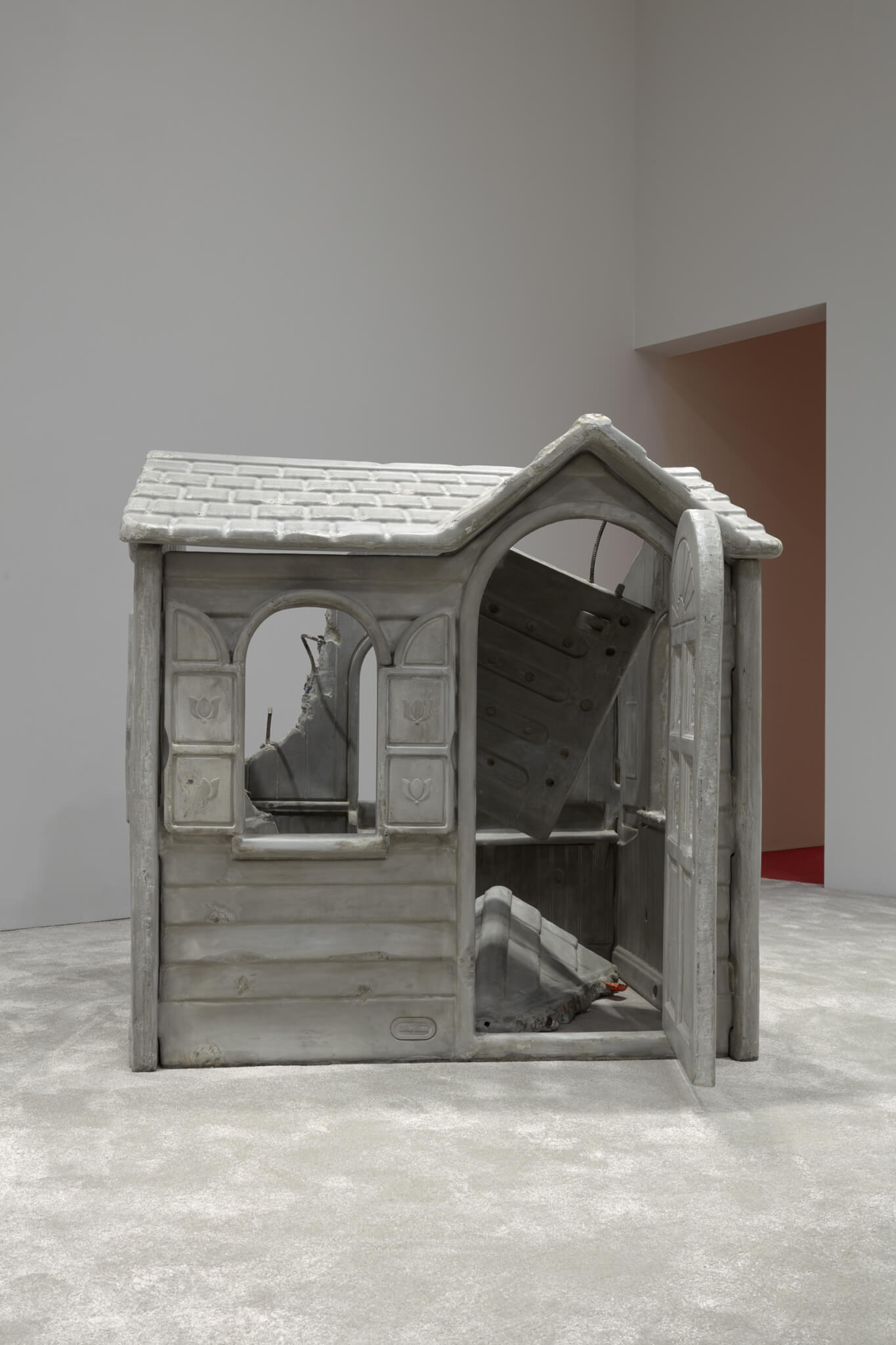Josh Kline: Project for A New American Century
Whitney Museum of American Art
New York
Through August 13
Josh Kline’s mid-career Whitney retrospective, Project for A New American Century, envelopes viewers in a funhouse, but a dark one: the parallel universe of American architecture of the ‘aughts. In Kline’s alternative America, accelerationist dreams come true with devastating consequences. Flooded streets make Manhattan a marsh, pink McMansions melt into goo, and abandoned wall-to-wall carpets extend into infinity. With his immersive installations combining art, sculpture and digital media, Kline conjures the only things threatening to puncture our pressure-cooker banality: catastrophe and obsolescence.
In 2002 architect Rem Koolhaas and critic Hal Foster coined the term “junkspace,” in the seminal essay by the same name. “Junk-space is the residue mankind leaves on the planet,” or “the product of an encounter between escalator and air-conditioning, conceived in an incubator of sheetrock.” Left servicing the junkspace is a labor force that has been similarly streamlined into the silos of efficiency. This society of junkspace has become the subject of Kline’s artwork, and in Project for a New American Century, his re-presentation of three architectural mainstays from the early 2000s—the corporate office, the warehouse fulfillment center, and the suburban house—is an experiential mix between garish and banal.

But Josh Kline refuses to be ambivalent. The curators claim his work “speaks to society on its own terms,” deploying recognizable forms popularized by media, architecture, and design, which he describes as “America’s true vernacular.” The exhibition contains a mixture of sculptures, installations, and videos from three bodies of work—Creative Labor (2009–2014), Blue Collars (2014–2020), and ongoing installations he began in 2014. These all highlight the themes of labor, surveillance, climate change, and the impact of automation. Sculptural groupings throughout the show form their own scenographic eras defined by shared samplings of ‘aughts vernacular.
Kline never went to art school. At Temple University he studied film and visual anthropology, which makes sense, as he heavily cites mass media as inspiration in his work. He uses pop culture juggernauts like the Star Trek series and Mad Men to explain America’s design trajectory from 20th century modernism to its facsimiles and offspring. The gestures at play here are what critic Colby Chamberlain recently described in Artforum as a “repetition compulsion in reaction to traumatic events,” as a protracted response to the trauma of 9/11 and the Bush administration’s war on terror. Though it might be a reach, these philosophical underpinnings help situate Kline’s architectural fantasies. Chamberlain goes on to describe how the film worlds Kline alludes to echo, but differ greatly from, our own use of Freud’s concept of the uncanny: the feeling of “reemergence of something once repressed.” Kline utilizes the uncanny in his work to, as Chamberlain puts it, trigger “a vague, persistent sense of being stuck in the wrong reality.”
In each section of uncanny scenography, Kline creates Americas parallel to the past, present, and future, an example of what architectural theorist Svetlana Boym calls an “architecture of the off-modern.” She describes media like films and models as ways to explore the gray areas next to linear history, “a modernity of what if.” Kline’s series could be seen as off-moderns like an architecture of an alternate ‘aughts.
Office Flood Zone
The first of Kline’s Alternates occupy a time in the near future, manifesting our fears of climate emergency through fictive scenarios. In a dark room with crate seating, a clicking projector shows the film Adaptation (2019–22): The setting is a futuristic Manhattan flooded by the sea. A small boat navigates the water between glass facades, looking into what was once lofty executive suites. Stories below its rudder, entrances sit unused at the base of empty towers. Divers come up to join the boat, which we can assume to be part of a cleanup crew. The work is described by the artist as “the science fiction of everyday life.” Relief workers bond over disaster, eating hoagies as they wistfully pass hundreds of empty towers, as if wading through a marsh of steel and stale air.

An orange glow leads to the series Climate Change is Personal Responsibility (2023-) where screening rooms are set up in tents printed to look like pop-up trailers, cars, storage containers, a bodega, and bedrooms. Actors tell us of their post-Anthropocene plight.
In this dissolved coastline version of America, temporary provisions become long-term, and work-place and home-place become interchangeable. This feels familiar; an accelerated hybridization of what’s already happening in reaction to market forces, like the relaxing of code requirements for the large-scale conversion of office towers into housing in New York City.
Warehouse
Kline’s next Alternate zooms in, focusing on the typology of the warehouse fulfillment center. Its trademark enormity feels like an endless interior in the show, representing architectural interest in the notorious “industrial aesthetic.” Like a SPAM can stripped of its label to reveal rippled aluminum, architecture extracts control over wholesale industrial materials like metal studs, CMU blocks, metal panels, and of course, concrete. As Koolhaas and Foster put it, “Continuity is the essence of Junkspace; it exploits any invention that enables expansion… It is always Interior, so extensive that you rarely perceive its limits; it promotes disorientation by any means (mirror, polish, echo).”

In the show we only see warehouse interiors, never a facade. In one scene from Climate Change is Personal Responsibility, we see a pair of pants mysteriously catch on fire, the screen itself sitting on a shelf amongst Amazon boxes, threatening thousands of goods likely surrounding it. These trappings are also present in Creative Labor, where the cast hands of Kline and his friends sit on industrial metal shelves that invoke warehouse storage and superstores, gesturing toward the bodily labor linked to production. This typology has no edges, no exit, a continuous absorption of stuff. It is akin to the lack of separation between worker and product, endlessly absorbing one other.
Suburban Leftovers
A soft gray carpet continues the vocabulary of the uncanny room after room on the museum’s fifth floor. These rooms present a few series of sculptures that invoke suburban ‘aughts aesthetics in-residence: twisted living rooms and office spaces where objects portray the plight of their residents. Civil War (2017) contains suburban appliances spliced together alongside overstuffed couches, piled in half-crushed states with rebar and phones in the mix. The Contagious Unemployment (Best Wishes) (2016) series, adjacent, has virus-shaped glass orbs containing banker boxes of personal belongings. Finally, Unemployment series (2016), is filled with realistically sculpted people wrapped in large plastic bags, dispersed between shopping carts of recast objects related to their professions lost to automation in the 2030s and 2040s
Maybe most recognizable are Kline’s re-presentations of the suburban house and his invocation of its role as a commodity that swings violently in value, incongruent with that of the land it sits on. Industrial steel sinks with pink casts of suburban houses melt slowly where they meet the metal in the sculptures of Consumer Fragility Breakdown (2019) and Domestic Fragility Breakdown (2019): The mix of resin, wax, and pigment slowly collect in a clear bag beneath the sink. The melting ‘aughts are a physical encapsulation of the feelings of millions who saw their homes disappear from underneath them during the 2008 foreclosure crisis.

After this pathway of alternative currents, Kline’s retrospective concludes with a sincere vision of utopia offered to now-traumatized visitors. Films titled Universal Early Retirement (spots #1 & #2) (2016) and Another America is Possible (2017) center multi-ethnic humans smiling with the eerie intensity of a Prozac ad while indifferently engaged in everyday hobbies and burning the confederate flag. Contemporary suburbia haunts the background of Universal, though, projecting the assumption that Universal Basic Income, a concept touted in the film, would only act on the built environment by letting it remain. Architecturally, Kline offers no Alternate here: Utopia is simply economic stability with more picnics. Nothing is flooded or melting, but in the building-less lush park of Another America, I wondered where the utopic humans go when it rains, or floods.
Utopian Art
Chamberlain made a heroic effort in Artforum, trying to situate Kline’s work within the art historical canon. But even so, in the end Chamberlain throws in the towel, nearly admitting that Kline defies art linage. In another context it might be fair to call Kline an outsider artist, a set designer, or an architect, but at the Whitney, we can’t help but see Kline’s work through the lens of a canonical institution interested in concretizing, and historicizing, legacy.
Perhaps what makes all of this art is that it provokes the viewer to imagine a future of different operational modes. As critic Fredric Jameson said, “utopia as a form is not the representation of radical alternatives; it is rather simply the imperative to imagine them.”
Kline asks viewers to “imagine alternatives to the dark scenarios he envisions, ultimately asking whether another, more utopian future is possible.” Of course, Kline’s Alternate ‘aughts are not quite architectural off-moderns, which Boym argues should expose the “invisible temporal dimensions of the present,” rather than “opening up into some catastrophic or messianic future.” In order to envision utopia—or at least something less bleak—Kline’s ‘aughts still offer a mode in which to melt, sink, or stretch known architectures to support the health and dignity of human life. A utopian architecture might just be something we haven’t imagined yet.
Angie Door is a writer and designer who lives in Brooklyn.











